CHAPTER 8: Agile Planning
The Competitive Edge for Modern Project Managers
8.1 Agile Planning Horizons From Portfolio to Daily
Agile Planning Horizons: From Portfolio to Daily
Agile planning is not a single activity. It happens across multiple levels, from strategic vision to daily execution. This layered approach ensures that teams are always aligned to organizational goals while remaining flexible.

Why Agile Uses Multiple Planning Horizons
Traditional project management often relies on one large, up-front plan. Agile recognizes that uncertainty increases as we look further into the future. Instead of one plan, Agile uses several levels of planning. Each level provides just enough direction while leaving space for adaptation. This creates both alignment and flexibility.
Portfolio Planning
At the highest level, portfolio planning ensures that the organization invests in the right initiatives. Leaders compare opportunities, consider risks, and allocate resources. The goal is to balance short-term needs with long-term strategy. Portfolio planning sets the broad direction but does not define the detailed features.
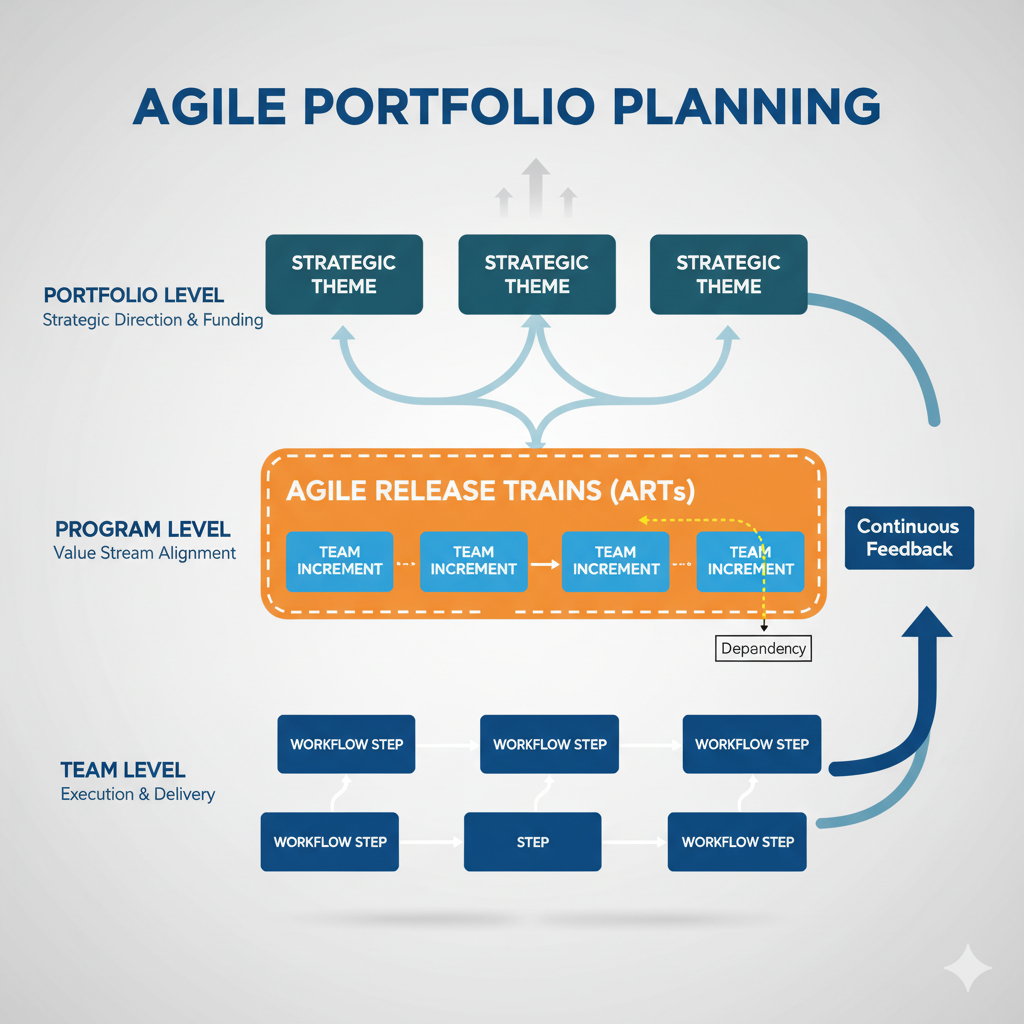
Product Planning
Product planning translates strategic intent into a vision and a roadmap. Here, product owners and stakeholders define outcomes and key milestones. A product backlog is started, containing features and epics that deliver business value. Unlike portfolio planning, this level focuses on a single product or service, ensuring it aligns with customer needs and business goals.
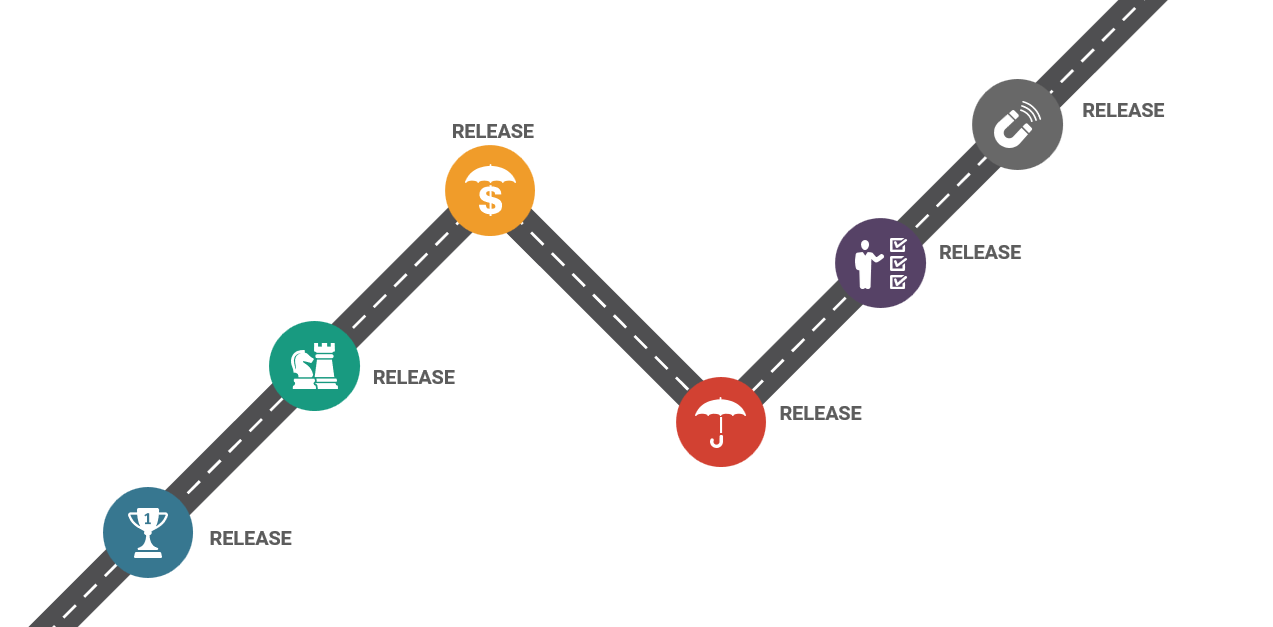
Release Planning
Release planning connects strategy with execution. Teams decide which features should be grouped into a release and when they might be delivered. A release may span several sprints, and planning here uses estimation and velocity to forecast. The release plan is not fixed; it adapts as the product backlog evolves and new insights appear.
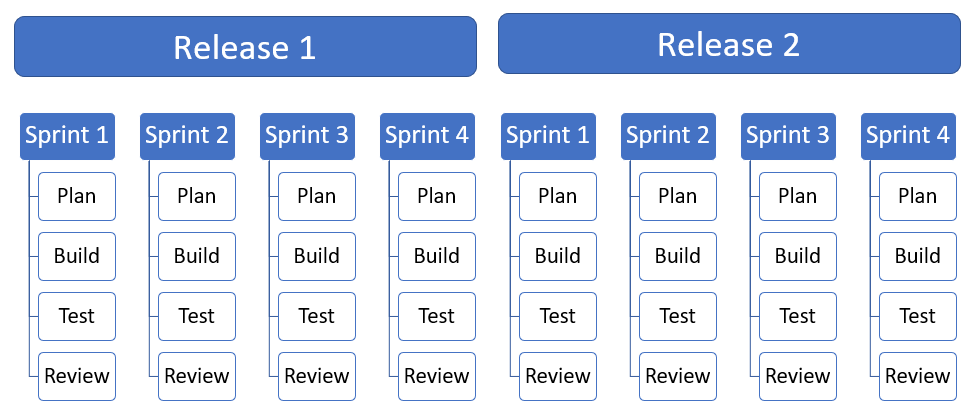
Sprint Planning
Sprint planning happens at the start of each sprint. The team looks at the product backlog, their capacity, and their velocity. They select items they believe they can complete and define a sprint goal. This level of planning is highly tactical, ensuring focus and commitment for the next short iteration.
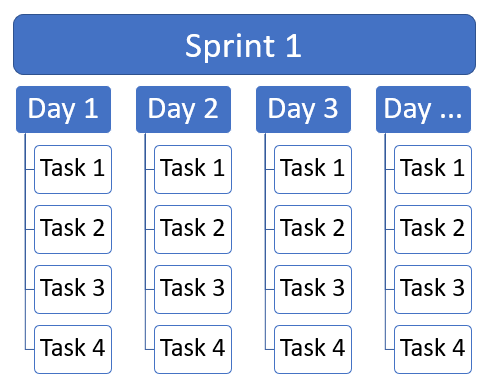
Daily Planning
Every day, the team inspects progress and adapts. This is the purpose of the daily Scrum. The plan for the next 24 hours may shift based on new information. Daily planning keeps the team synchronized and removes obstacles quickly. It is the most flexible and adaptive of all planning levels.
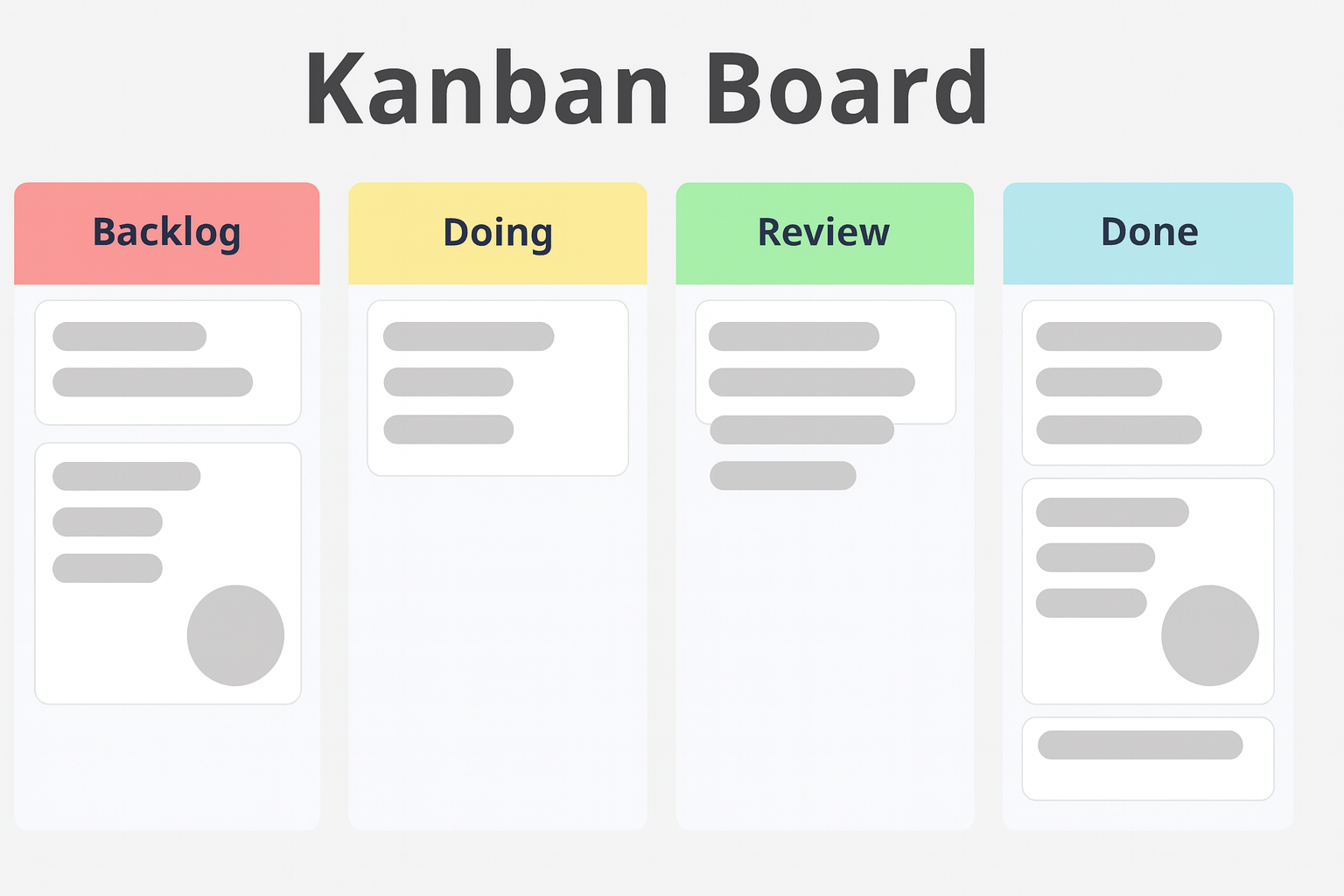
How the Horizons Connect
Each planning horizon feeds into the next. Portfolio decisions influence product roadmaps. Product roadmaps guide release planning. Releases shape sprint planning. And sprints drive daily actions. Together, these levels create a coherent system that links strategic vision to daily work, while allowing learning and adaptation at every stage.
8.2 Balancing Predictive and Adaptive Planning
Balancing Predictive and Adaptive Planning
Agile planning is not about abandoning structure. It is about finding the right balance between predictive up-front work and adaptive, just-in-time adjustments. This balance allows teams to reduce risk, respond to change, and still maintain direction.
What Predictive Planning Provides
Predictive planning means setting expectations in advance. It creates initial alignment on goals, budgets, and time frames. This type of planning is valuable because it provides stakeholders with confidence and clarity. It ensures the team has a shared starting point before diving into detailed work.
The Limits of Predictive Planning
While predictive planning offers direction, it cannot account for everything. Complex projects are filled with unknowns, shifting priorities, and evolving customer needs. Relying too heavily on predictive planning risks locking teams into outdated assumptions. This often leads to waste, rework, and missed opportunities.
Why Adaptive Planning Is Essential
Adaptive planning embraces change as new information emerges. Instead of assuming the plan will remain valid, Agile teams expect to adjust it. This approach allows for faster learning, improved risk management, and better customer outcomes. Adaptive planning ensures that effort is always aligned with the highest value opportunities.
Finding the Balance
Agile does not reject predictive planning. Instead, it combines a light layer of predictive planning with continuous adaptation. Teams define a vision, outline major releases, and set expectations. Then they adjust those plans frequently based on stakeholder feedback, sprint reviews, and changing business conditions. The key is to plan enough to guide action but not so much that plans become rigid.
Techniques to Support Balance
Several techniques help achieve this balance. Product roadmaps provide a predictive view of direction, while backlog refinement ensures adaptiveness. Estimation and velocity forecasting give stakeholders useful projections, but teams revisit them regularly. Sprint goals provide short-term commitment, while release reviews allow long-term adjustments.
Economic Sense of Planning
From an economic perspective, predictive planning reduces the cost of uncertainty, while adaptive planning reduces the cost of change. Agile teams weigh both to ensure resources are used wisely. The best balance depends on project complexity, stakeholder expectations, and the pace of learning needed.
Balancing predictive and adaptive planning is at the heart of Agile. Predictive planning offers direction, while adaptive planning ensures flexibility. Together, they help teams deliver value while staying resilient to change.
8.3 Release Planning in Agile Projects
Release planning in Agile projects
Release planning connects strategy to delivery. It answers what we will deliver, why it matters, and when it is likely. A release bundles valuable features into a cohesive outcome for users. The plan gives stakeholders a shared target while preserving flexibility. It does not lock every detail. It sets intent, scope range, timing range, and quality expectations. The plan evolves as learning grows.
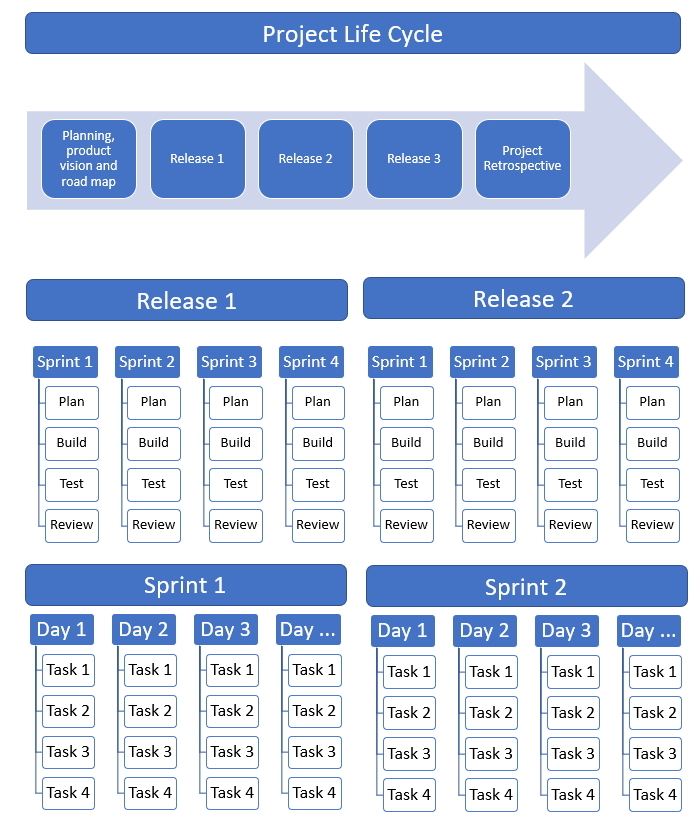
What a release plan achieves
A release plan sets direction and reduces uncertainty. It outlines the goal of the release and key outcomes. It proposes a delivery window that is realistic. It sequences features into sprints to build value early. It defines quality and readiness expectations for launch. It highlights risks and dependencies that could impact timing. It clarifies how success will be measured after release. It creates shared ownership across the team and stakeholders.
When and how often to plan
Release planning happens early and is revisited often. Teams run an initial session once vision and backlog exist. They then refresh the plan after each sprint review. Refresh cycles range from two to six weeks. The cadence depends on product volatility and risk. High-change environments adjust more frequently. Stable environments adjust less often. The plan is living, not a one-time document. Inspect and adapt keeps it useful.
Key inputs to release planning
Bring a small set of focused inputs. Use only what improves decisions. Typical inputs include: - Product vision and measurable outcomes. - Roadmap themes and time horizons. - Prioritized product backlog with acceptance criteria. - Team capacity, historical velocity, and availability. - Definition of Done and nonfunctional standards. - Risks, constraints, and key dependencies. - Stakeholder dates, policies, or regulatory deadlines.
Core outputs of release planning
Capture outputs that enable action. Keep them concise and clear. Useful outputs include: - A release goal that states the customer outcome. - A feature set scoped as a range, not a promise. - A forecasted window, expressed as earliest and latest dates. - A sprint-by-sprint feature sequence that maximizes value early. - Explicit quality and readiness criteria for launch. - A risk view and mitigation plan for top threats. - A communication plan and reporting rhythm.
Who participates and why
Release planning requires cross-functional collaboration. The Product Owner leads on value and scope. The Scrum Master facilitates process and timeboxes. The Developers contribute estimates and sequencing options. Stakeholders share constraints and learning from customers. Operations and security advise on readiness and compliance. Everyone aligns on the release goal. Everyone commits to transparency on risks and trade-offs. Shared understanding beats detailed documents.
The flow of a release planning workshop
Run a crisp, timeboxed workshop. A proven flow looks like this: - Frame the goal and success measures for the release. - Review prioritized backlog items that support the goal. - Clarify acceptance criteria and nonfunctional needs. - Size or confirm estimates at a coarse level. - Forecast using capacity and velocity ranges. - Sequence features to deliver value early. - Identify risks, dependencies, and integration points. - Define the release readiness checklist and owners. - Agree on communication and review cadence.
Key Definitions
Before we dive deeper into release planning, it is important to clarify a few key terms. We will cover Agile estimation in detail in the next section, but for now here is a simple view. Velocity is the measure of how much work a team can finish in a sprint, based on past performance. Story points represent the relative effort or complexity of completing a user story. Capacity is the amount of work the team can realistically commit to during a sprint, taking into account availability, skills, and other commitments. These three concepts work together to help teams plan achievable releases with confidence.
Forecasting with ranges, not single dates
Agile forecasts communicate uncertainty honestly. Use velocity ranges, not a single number. Express dates as windows, not fixed days. Show what scope fits within a window at a given confidence. Offer options by trading scope, timing, and resources. Update the forecast after each sprint with real data. Communicate changes promptly and clearly. Stakeholders value transparency over false precision.
Using velocity and capacity
Velocity converts story points into a time forecast. Start with historical velocity if available. Otherwise, use a conservative range. Adjust for holidays, onboarding, and parallel work. Capacity accounts for team availability and interruptions. Combine both to project how many points fit per sprint. Then roll up sprints to form a release window. Revisit numbers as the team stabilizes. Do not overfit early data.
Shaping scope to fit constraints
Constraints differ by product and context. Sometimes timing is firm. Sometimes scope is firm. Sometimes budget is firm. In Agile, the team protects value and quality first. Teams shape scope through thin slices and feature toggles. They focus on must-have outcomes for users. They defer lower value items to later releases. They keep the release coherent and testable. They never trade away security or safety.
Managing risk and dependencies
Risks and dependencies drive release realism. Map technical, operational, and market threats early. Mitigate through spikes, prototypes, or vendor alignment. Pull risky work forward to learn sooner. Break large dependencies into negotiable pieces. Timebox exploration to prevent drift. Maintain a visible risk list with owners. Use a simple risk burndown to track exposure. Celebrate removed risks, not only delivered features.
Release readiness and quality gates
Decide what “ready to release” means. Define clear criteria before development. Typical criteria include: - All acceptance tests pass at the release boundary. - Performance, security, and compliance checks pass. - Telemetry and logging support fast diagnosis. - Rollback and feature toggles are available and tested. - Support materials and runbooks are prepared. - Stakeholders approve demoed outcomes. Criteria protect customers and reduce surprises.
Tracking progress toward the release
Visualize progress with simple artifacts. A release burnup shows scope and delivered value over time. A cumulative flow diagram reveals flow issues. A release goal scoreboard tracks outcome metrics. Sprint reviews provide qualitative insight and feedback. Publish a one-page update after each review. Use the data to refine forecast and scope. Keep the narrative honest and focused on outcomes.
Worked example: online retail checkout release
Assume an online retail team targets a “Minimum Viable Product (MVP)” checkout release. The release goal is secure checkout for credit cards. The prioritized items are user registration, cart, payment gateway, order confirmation, and basic reporting. The team estimates ninety story points for these items. Historical velocity is sixteen to twenty points per sprint. The team plans three sprints and a flexible release window.
Building the forecast for the example
With sixteen to twenty points per sprint, three sprints deliver forty-eight to sixty points. The ninety points do not fit in three sprints. The team shapes scope to protect the goal. They keep secure payment and confirmation. They trim advanced reporting and coupons. They plan registration, cart, and payment in sprints one and two. They schedule confirmation and hardening in sprint three. They present a four to six week window.
Example risks and readiness decisions
The team identifies a payment gateway dependency. They schedule a technical spike in sprint one. Security testing is a readiness gate. They plan performance tests in sprint three. Feature toggles protect incomplete features. They prepare rollback and monitoring plans. Stakeholders accept the scope trade-offs. The team commits to demo at each sprint review. The release window remains flexible, based on test outcomes.
Adapting the plan as you learn
Every sprint brings new information. Teams inspect progress and adjust scope or timing. If velocity rises, they may pull in deferred items. If risks grow, they may reduce scope to protect the window. Outcome metrics guide choices, not opinion. The plan tells the current best path, not the only path. Adaptation is a sign of professionalism, not failure. Transparency maintains trust during changes.
Practical facilitation tips
Good facilitation makes planning effective and fast. Timebox discussions and keep artifacts visible. Separate brainstorming from commitment. Capture decisions and owners in the moment. Use ranges and options to improve negotiation. Anchor on the release goal when debates stall. Invite the right stakeholders, not everyone. End with a clear summary and next steps. Follow up with a concise, shareable one-pager.
Closing thoughts on release planning
Release planning aligns value, feasibility, and timing. It turns a prioritized backlog into a believable journey. It respects uncertainty with ranges and options. It protects customers through readiness criteria. It learns fast by sequencing risky work early. It remains alive through regular refresh. Plan with clarity, deliver in slices, and adapt with evidence. Your releases will land smoothly and create real value.
8.4 Sprint Planning Capacity, Commitment, and Goals
Sprint Planning: Capacity, Commitment, and Goals
Sprint planning is where vision turns into immediate action. It is the ceremony that sets the tone for each sprint, ensuring that the team knows what they will work on and why it matters. In this section, we will explore the purpose of sprint planning, how to estimate capacity, how commitment is formed, and how to create effective sprint goals. We will also walk through an example to make the process clear and practical.

The purpose of sprint planning
Sprint planning is not just about filling the sprint with tasks. Its purpose is to create a shared plan that the whole team believes is achievable. The session connects the product backlog with the team’s capacity, producing a sprint backlog and a sprint goal. It ensures everyone starts the sprint aligned on what will be delivered, how it supports the product vision, and what success will look like at the end.
Inputs to sprint planning
Several key inputs make sprint planning effective. These include the prioritized product backlog prepared by the Product Owner, the team’s velocity or historical data, the availability and capacity of team members, and the definition of done. Stakeholder priorities and any known constraints are also important. By bringing these inputs into the planning meeting, the team avoids guesswork and bases its plan on real data.
Understanding team capacity
Capacity tells us how much the team can realistically take on in the sprint. It is based on how many people are available, their skills, and the number of working days. If a team has five members working full-time in a two-week sprint, the total possible hours may be 400. However, capacity is rarely at 100 percent, because people need time for meetings, support, and unplanned work. Adjusting capacity with these factors creates a more accurate picture of what can be done.
Using velocity for forecasting
Velocity is a measure of how much work, expressed in story points, a team has completed in recent sprints. While it does not predict the future perfectly, it helps teams avoid overcommitting. For example, if a team has delivered about 30 points per sprint over the last three sprints, it is reasonable to plan for around that number in the next sprint. Velocity is not a target to be maximized, but a guide for sustainable planning.
Forming commitment
In sprint planning, the team, not the Product Owner or stakeholders, makes the final commitment. The Product Owner proposes high-value backlog items, but the developers decide what they can complete given their capacity and velocity. Commitment is not about pleasing management or stakeholders. It is about creating a realistic plan that the team can deliver with confidence. A good commitment strengthens trust between the team and stakeholders.
Creating a sprint goal
The sprint goal is a short statement that captures the essence of the sprint. It provides focus and direction, guiding decisions during the sprint. A strong sprint goal links backlog items together under a meaningful theme. For example, “Enable users to securely complete purchases with credit cards” is more helpful than “Work on payment stories.” The goal should be specific enough to guide but flexible enough to allow adjustments if needed.
Breaking down stories into tasks
After the team selects backlog items, they break them into smaller tasks. This makes the work more visible and manageable. Tasks are often estimated in hours and help confirm whether the commitment is realistic. Breaking down work also exposes dependencies and clarifies who will take on what. A transparent sprint backlog ensures that everyone knows what needs to be done each day.
Example: sprint planning for an online shopping app
Imagine a team building an online shopping application. The Product Owner has prioritized several stories: “As a shopper, I want to add items to my cart,” “As a shopper, I want to remove items from my cart,” and “As a shopper, I want to view the total price of my cart.” The team has a velocity of 25 story points and estimates the three stories at 8, 5, and 8 points. They discuss capacity and confirm that all five members will be available for the full sprint. Based on this, they commit to all three stories.
Example continued: creating a sprint goal
Instead of simply listing three stories, the team creates a sprint goal: “Deliver a functional shopping cart that supports adding, removing, and viewing items.” This goal gives clear direction. If an unexpected issue arises and they must drop work, they can prioritize features that still achieve a functional cart. The sprint backlog now contains the tasks needed for each story, such as database updates, user interface adjustments, and test scripts.
Facilitation tips for sprint planning
Good facilitation makes sprint planning effective and efficient. Timebox the session, usually to two hours for a two-week sprint. Ensure the backlog is refined beforehand so the meeting does not become a debate about unclear items. Keep the focus on outcomes, not just output. Encourage all team members to speak, since commitment requires everyone’s voice. Close the meeting with a clear sprint goal, committed items, and a visible sprint backlog.
Scrum Sprint Rules
In Scrum, once a sprint begins, the sprint backlog is locked. The team makes a commitment to complete the selected backlog items, and no new stories are added until the sprint ends. This rule gives the team stability and focus, preventing scope creep and constant interruptions. A sprint is timeboxed to two to four weeks, long enough to build something meaningful but short enough to adapt quickly at the next planning session.
Rules Can Be Broken
Other Agile frameworks handle this differently. For example, Kanban follows a continuous flow model where new work can be introduced at any time. Some hybrid frameworks also allow mid-sprint adjustments under special circumstances. Scrum, however, emphasizes that the sprint backlog should remain fixed during the sprint, with changes and reprioritization handled in future sprints. This discipline is part of what makes Scrum predictable and effective.
Common pitfalls to avoid
Several pitfalls can weaken sprint planning. Overcommitting leads to unfinished work and frustration. Allowing external pressure to dictate the plan undermines trust. Starting with an unrefined backlog wastes time. Ignoring capacity and velocity results in unrealistic expectations. Finally, skipping the sprint goal removes focus and makes prioritization harder. Awareness of these pitfalls helps teams avoid them.
Closing thoughts
Sprint planning is more than a scheduling meeting. It is a collaborative process where the team takes ownership of the next sprint. By using capacity, velocity, and backlog priorities, the team makes a realistic commitment. By creating a sprint goal, they ensure focus and purpose. With practice, sprint planning becomes a reliable engine that drives value delivery, sprint after sprint. In the next section, we will move on to Agile estimation, which provides the foundation for accurate forecasting and planning.
8.5 AI for Release and Sprint Planning
AI for Release and Sprint Planning
Planning is one of the most time-consuming activities in Agile projects. Teams must translate product backlogs into release forecasts and sprint commitments, often juggling complex dependencies, shifting priorities, and uncertain capacity. Artificial Intelligence can make this process faster and more reliable by crunching numbers, spotting risks, and drafting plans that humans refine. Now, let's look at six specific AI prompts—three focused on release planning and three on sprint planning—and see how they help teams plan with greater clarity and confidence.
AI prompt: drafting a release plan
One powerful way to use AI is to generate a first draft of a release plan. The prompt is: “Based on this product backlog [insert backlog items with story points, priorities, dependencies], create a draft release plan for the next 3 months. Show which features could be included in each release.” By feeding the backlog data into AI, teams quickly receive a structured draft showing how features might be grouped into releases. This gives stakeholders something tangible to react to, instead of starting from a blank page. The draft will not be perfect, but it reduces preparation time and sparks constructive discussion about priorities and sequencing.
AI prompt: forecasting with velocity ranges
Forecasting is a constant challenge in Agile, especially when multiple releases are in play. The prompt here is: “Given the team’s historical velocity [insert data], forecast the number of story points that can fit into three releases and present options with best-case and worst-case ranges.” AI can process past velocity data quickly, run multiple scenarios, and show outcomes for optimistic and conservative cases. This helps teams and stakeholders see the uncertainty upfront and plan with realistic expectations. Instead of promising one fixed date, they can communicate a delivery window and adjust scope or timing as new data emerges.
AI prompt: identifying risks and dependencies
Even a well-sequenced release plan can fall apart if risks or dependencies are missed. AI can support by using this prompt: “Identify risks and dependencies in this release backlog [insert items]. Suggest strategies to mitigate them during release planning.” With this, AI highlights where external vendors, technical bottlenecks, or cross-team dependencies might affect delivery. It can also suggest mitigation approaches, such as scheduling spikes, adjusting sequence, or negotiating with stakeholders. By surfacing these insights early, teams can avoid costly surprises and build more resilient release plans.
AI prompt: workload versus capacity in sprint planning
When planning sprints, one of the hardest tasks is matching the sprint backlog to the team’s actual capacity. The relevant prompt is: “From this sprint backlog [insert backlog items], estimate the total workload and compare it to the team’s capacity of [X] hours or [Y] story points.” AI can add up the backlog effort, compare it against available capacity, and flag whether the plan is overcommitted or underloaded. This helps teams adjust before the sprint begins, reducing the likelihood of unfinished stories or wasted capacity. It makes sprint commitments more realistic and sustainable.
AI prompt: writing an outcome-focused sprint goal
Clear sprint goals guide the team and create alignment with stakeholders. However, many teams struggle to phrase them well. AI can help with this prompt: “Help us write a sprint goal for these selected backlog items that is short, clear, and outcome-focused.” AI can draft several goal statements, focusing on customer value instead of just listing tasks. For example, instead of “Work on payment stories,” AI might suggest “Deliver a secure checkout flow that enables customers to complete purchases.” The team still chooses the final wording, but AI saves time and improves quality.
AI prompt: breaking down user stories into tasks
Sprint planning also requires turning stories into tasks that can be tracked and completed. The prompt is: “Break down this user story [insert story] into smaller tasks, each estimated in hours, to make it sprint-ready.” AI can generate a logical breakdown such as design, coding, testing, and documentation, and provide rough time estimates. The team then reviews and adjusts. This ensures stories are sprint-ready faster, supports better workload distribution, and makes progress more visible throughout the sprint.
Closing thoughts
AI does not replace the judgment of Agile teams, but it removes heavy manual work from planning. By drafting release plans, forecasting velocity ranges, highlighting risks, checking workload, shaping sprint goals, and breaking down stories, AI helps teams plan smarter and faster. The team remains responsible for commitments, but with AI as a planning assistant, they enter release and sprint planning sessions better prepared and more confident in their decisions.
Agile Project Management & Scrum — With AI
Ship value sooner, cut busywork, and lead with confidence. Whether you’re new to Agile or scaling multiple teams, this course gives you a practical system to plan smarter, execute faster, and keep stakeholders aligned.
This isn’t theory—it’s a hands-on playbook for modern delivery. You’ll master Scrum roles, events, and artifacts; turn vision into a living roadmap; and use AI to refine backlogs, write clear user stories and acceptance criteria, forecast with velocity, and automate status updates and reports.
You’ll learn estimation, capacity and release planning, quality and risk management (including risk burndown), and Agile-friendly EVM—plus how to scale with Scrum of Scrums, LeSS, SAFe, and more. Downloadable templates and ready-to-use GPT prompts help you apply everything immediately.
Learn proven patterns from real projects and adopt workflows that reduce meetings, improve visibility, and boost throughput. Ready to level up your delivery and lead in the AI era? Enroll now and start building smarter sprints.
Launch your Agile career!
HK School of Management helps you master Agile and Scrum—faster. Learn practical playbooks, AI-powered prompts, and real-world workflows to plan smarter, deliver sooner, and keep stakeholders aligned. For the price of lunch, you’ll get templates, tools, and step-by-step guidance to level up your projects. Backed by our 30-day money-back guarantee—zero risk, clear path to results.
Learn More HKSM
HKSM
